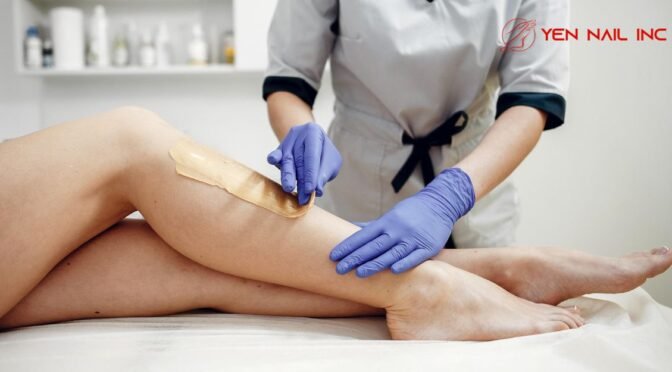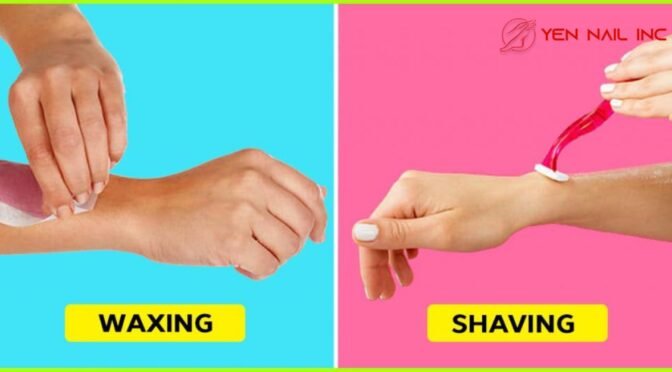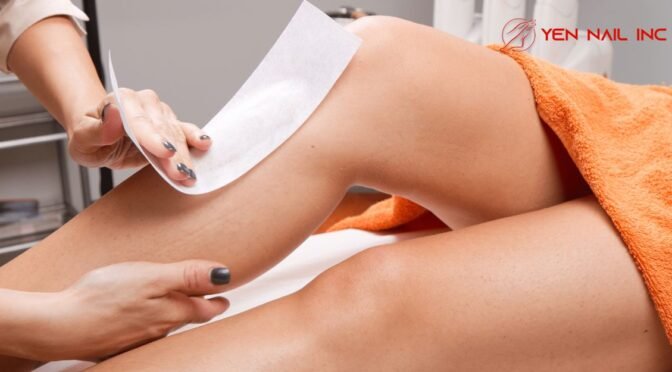Waxing has been one of the most popular methods for removing hair for a very long time; however, there are still a few misunderstandings about it that frighten people from using its benefits. If you are planning to go to a professional salon in Aurora, such as Yen Nails, for the first time and you don’t know what to expect, or you are already familiar with the process, it will help you to separate facts from myths to make a right decision about your skincare routine. Experts in the beauty industry report that the myths about waxing which have been around for a long time have been disproved by them with the assistance of science.
Myth 1: Waxing Makes Hair Grow Back Thicker and Darker
This is still the largest misunderstanding that has been around for a long time in the beauty industry and the truth is that it is totally false. The publication Scientific American refutes the idea that waxing leads to thicker and darker hair regrowth as it says that the belief has no support in science. The reason for the confusion must be that people mix waxing and shaving, the latter cutting the hair at the surface and thus leaving a blunt, coarse tip which looks thicker when the hair grows back due to the fact that it is shorter.
Waxing works fundamentally differently by removing hair from the root rather than cutting it at the surface. When hair regrows after waxing, it emerges from the follicle with a naturally tapered, soft tip. A comprehensive literature review published in the National Institutes of Health confirmed that hair removal methods can be categorized into depilation (removing the hair shaft) and epilation (removing hair from the root), with waxing falling into the latter category. The study emphasizes that epilation methods like waxing do not alter the fundamental characteristics of hair follicles.
One of the mechanisms by which waxing over a long period weakens hair follicles and results in finer and less hair is reported by research. According to the research published in the prestigious journal Clinical and Experimental Dermatology in 2020, a study on different hair removal behaviors, the most common method of hair removal, waxing, alongside other epilation methods, changes the morphology of the hair follicle over time and does not lead to an increase in thickness. After the repeated waxing three times with intervals of four to six weeks, many clients notice that their hair has significantly reduced and that it has become softer in texture. Some hair follicles may even cease to produce hair altogether as a result of repeated professional waxing.
Myth 2: Waxing Causes Premature Aging and Skin Damage
Many people fear that the pulling motion involved in waxing will damage skin elasticity and cause premature aging. This myth is categorically false when waxing is performed by trained professionals using proper techniques.
The same 2020 dermatological study that examined waxing’s impact on skin found no evidence that a single waxing treatment induced any biophysical changes in skin quality, including skin barrier integrity, elasticity, or roughness. Researchers measured multiple skin parameters 48 hours after waxing and concluded that the procedure does not compromise the mechanical or elastic properties of skin. This scientific evidence directly contradicts the aging myth.
Skilled estheticians know exactly how to hold the skin during waxing to ensure hair is removed without pulling or damaging the skin itself. The eyebrow and upper lip areas have the thinnest skin on the face, yet hair can be safely removed from these delicate zones without any harm. Furthermore, waxing is performed once every four to six weeks, not daily, making it far less impactful than daily habits that genuinely contribute to aging.
Actual causes of premature aging include free radical damage from sun exposure, smoking, poor diet, genetic predisposition, and overall health conditions—not waxing. When performed professionally, waxing actually benefits your skin by acting as a natural exfoliant. The process removes dead skin cells along with unwanted hair, leaving skin smoother, more radiant, and promoting healthy cell regeneration.
Myth 3: Waxing Is Unbearably Painful for Everyone
While waxing involves some level of discomfort, it’s far from the excruciating experience many imagine. Pain perception during waxing varies significantly based on individual pain tolerance, hair thickness, skin sensitivity, and the specific body area being treated.
Research ironically points out that there are pretty major differences in how men and women feel pain while being waxed. A study by Australian Bodycare found out that 83% of salon therapists say that women can tolerate more pain than men in waxing. This means that both nature and nurture probably play a role in the way some people feel the pain of waxing.
Professional techniques and premium wax products substantially reduce discomfort. High-quality hard wax, commonly used in Aurora salons, adheres primarily to hair rather than skin, making it gentler and less painful, especially for sensitive areas like the face, underarms, and bikini line. Studies comparing pain levels across different body areas show that waxing discomfort ranges from moderate (legs and arms) to higher intensity (bikini area), but proper technique and quality products minimize this sensation.
The actual removal happens in just seconds with one swift pull, minimizing prolonged discomfort. Regular waxing progressively weakens hair follicles over time, making each subsequent appointment increasingly comfortable. Beauty experts describe waxing as “good hurt”—temporary discomfort with lasting benefits—rather than “bad hurt”. Taking an over-the-counter pain reliever 30 minutes before your appointment, avoiding caffeine, and scheduling sessions outside your menstrual cycle when skin is less sensitive can further minimize any discomfort.
Myth 4: You Can’t Wax During Pregnancy
Expecting mothers often hear warnings against waxing during pregnancy, but medical evidence confirms that waxing is generally safe throughout all stages of pregnancy. No scientific research has been found that links waxing to miscarriage or harming the unborn baby.
Doctors and specialists in the medical field agree that there is no risk involved if a pregnant woman removes her hair by any means such as waxing or shaving. The skin during pregnancy becomes more sensitive due to hormonal changes and it is also more vascular, hence waxing may cause more discomfort than what the pregnant woman is used to. However, professional estheticians experienced in prenatal waxing can adjust their techniques accordingly.
A 2020 study examining the impact of different hair removal behaviors on skin biophysical parameters found that while waxing does trigger temporary inflammatory responses (increased levels of interleukins IL-1α and IL-1RA), these are normal, localized skin reactions that resolve quickly and pose no systemic health risks. This research confirms that the body’s response to waxing is limited to the immediate treatment area and does not affect pregnancy outcomes.
Healthcare professionals suggest that one should not wax areas that have some kind of specific condition such as varicose veins, melasma (dark skin patches), rashes, open cuts, or irritated skin. The above-mentioned precautions are mainly taken to avoid temporary side effects like redness, slight swelling, or folliculitis which are caused in the area, thus, waxing is not considered inherently dangerous. Brazilian waxing is generally considered safe during pregnancy when it is done at a salon with a reputable and gentle, skin-friendly wax type. In case of a high-risk pregnancy or if you have any particular concerns, consult your doctor before waxing, but the majority of pregnant women, with the help of a professional, can continue their waxing routines safely.
Myth 5: Waxing Is Only Safe in Winter, Not Summer
Some believe summer heat, swimming, and sun exposure make waxing unsafe during warmer months. While waxing requires specific precautions during summer, it remains perfectly safe and actually offers particular advantages for the season.
The main point to keep in mind is the protection of a newly waxed body against the sun. In fact, right after waxing, your skin is even more vulnerable to UV rays as the procedure opens up the hair follicles and removes the layer of dead skin cells that is there for protection. A study dedicated to the care of the skin after wax goes to show that photosensitivity is temporarily increased by the wax treatment, thus the use of sun protection becomes absolutely necessary within the first 24 to 48 hours after the procedure. Professionals in the beauty industry advise that direct sun exposure should be avoided for 24 hours both before and after waxing sessions. It is very important to apply sunscreen as soon as the skin is no longer very sensitive.
The 2020 dermatological study examining waxing’s effects on skin found that while waxing increases erythema (skin redness) temporarily, these effects return to baseline within 48 hours. This scientific evidence confirms that waxing’s impact on skin is temporary and manageable with proper aftercare.
Waiting 24 hours before swimming in pools, lakes, or oceans after waxing is a must as bacteria present in these places can get into open follicles and cause infections. But after this short waiting period, summer is actually a great time to wax. Since waxing is done at the root, the results are visible for three to six weeks—thus beach holidays and pool parties without the need for daily maintenance are perfect. The skin-smoothing and shining effect of waxing, which is great for summer, is also a side of the season. Following professional aftercare advice such as frequent moisturizing, exfoliating, and wearing loose-fitting clothes after appointments is a way to have safe and lovely results all summer long.
Making Informed Waxing Decisions in Aurora
Professional beauticians at top-tier Aurora salons such as Yen Nails have the education, the know-how, and use the best-quality products to perform safe and effective waxing services. Knowing the scientific facts that disprove these myths gives you the power to go on and make a rational decision that waxing is indeed a trustworthy hair removal method. If waxing is done with the right prep, by a skilled professional, and with the suitable aftercare, it is a very effective way to have smooth skin for a long time, as well as hair growing back finer and healthier skin that is glowing, no matter what the season is, what your skin type is, or what stage of life you are in.






